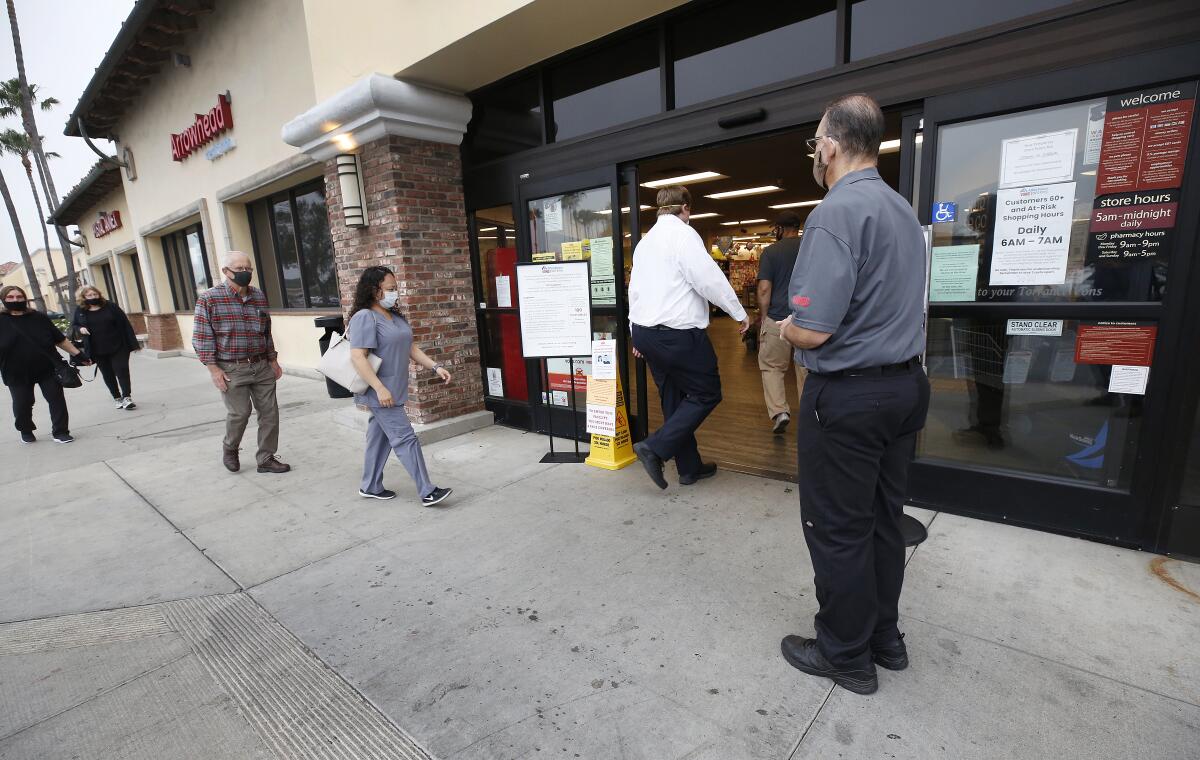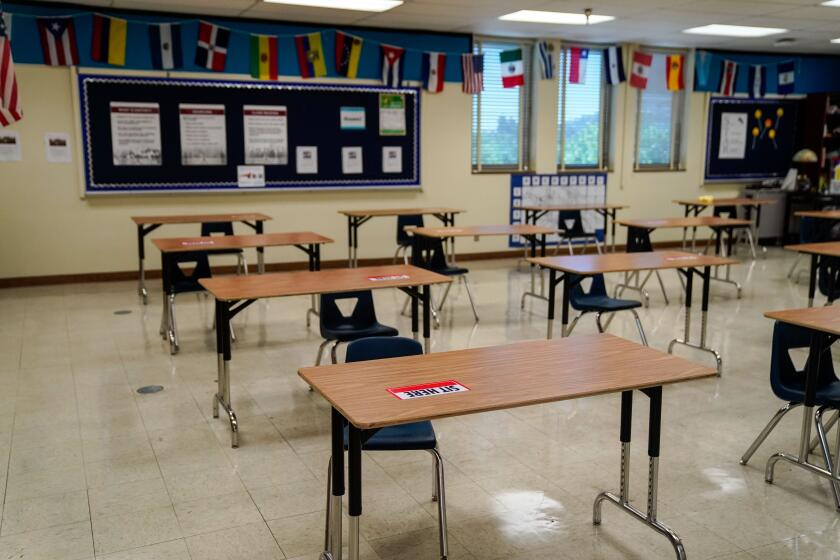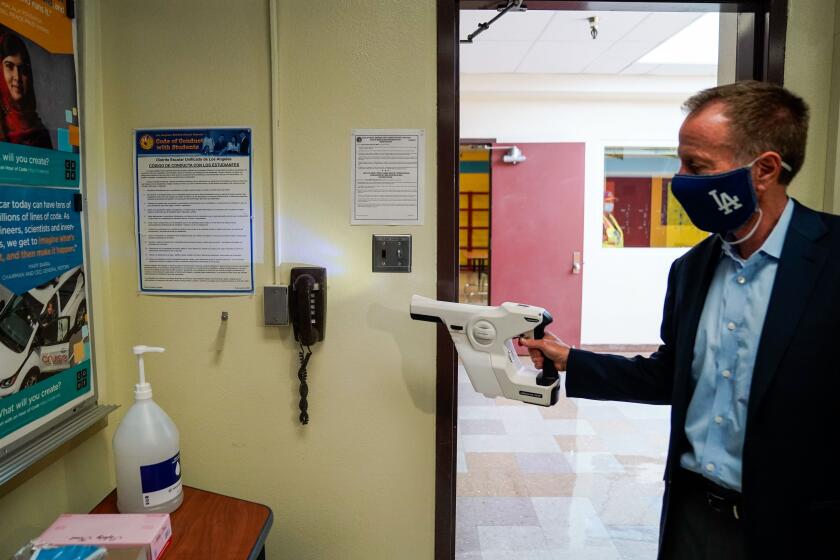What can parents who work outside the home do about remote schooling?

- Share via
With California schools starting up again virtually, many parents are wondering how they can get back — or stay — at work if their kids can’t physically go back to class.
It’s not a one-size-fits-all conundrum. Two-parent households of means might be able to work from home and take turns helping kids navigate distance learning or hire a tutor. A single parent who is an essential worker might find herself with fewer options.
Daniel Alvarez, who works in a food facility, said he isn’t sure how his family is going to manage his two school-age kids’ studies when his wife is finally able to return to her job as a hair stylist.
“What do we do?” Alvarez said recently while waiting in line with other parents for donated backpacks, school supplies and pantry items in East Los Angeles.
L.A. Unified School District, which serves more than 600,000 kids, including Alvarez’s, will have online learning until further notice because of a surge in coronavirus cases. Gov. Gavin Newsom has also said that school districts can’t reopen for in-person instruction if they’re in a county that’s on the state watch list. Only those that have been off the list for more than 14 days are allowed to reopen for in-person instruction, Newsom said.
“Of course we want to be in compliance, we want everybody to be safe,” Alvarez said. “But we still need that second income to survive.”
So what can parents in similar or equally untenable situations do?
The new school year of remote learning will bring unique challenges. Here are guides to help parents of school-age children navigate remote learning, as well as recent updates about education in Southern California.
Check with your district
Some school districts are offering support to working parents, or are considering means of support. It’s key to look out for updates and see if there’s any news you missed.
The Glendale Unified School District, for example, is rolling out on-campus, supervised “technology pods” for elementary children. Held in classrooms and other spaces during regular school hours, children of parents who opt into the program will be assigned to a small group whose members can access distance learning by their regular teachers, according to district officials. A substitute teacher or certified aid will provide support. Children and staff in the pods will be physically distanced and won’t interact with members of other pods.
“These pods are designed to essentially allow working parents an alternate to child care,” said Neda Farhoumand, former Glendale Council PTA president. “And I will say the interest has been tremendous, much more I think than anyone expected.”
Meanwhile. Los Angeles County is considering using parks and libraries in unincorporated areas as alternative learning sites for students, following a proposal by the L.A. County Board of Supervisors.
A report outlining a plan to provide staffing, supervision and programming to children is expected to arrive in late August.
L.A. Board of Education approves agreement with union for structured online teaching. Critics say it needlessly shortens the traditional school day.
Check with your employer
Some employers offer paid leave for caregivers, flexible work schedules and stipends for child care.
When schools first closed in the spring amid the pandemic, several of California’s largest employers stepped up their efforts to help working parents manage distance learning. Many of those measures were intended to be short-term, to get parents over what was previously thought to be a hump with an end in sight. Some have expired or will shortly.
But with “the end” growing ever hazier, those same employers are being forced to consider what to do next — and soon. Unions representing large contingencies of workers are urging employers to extend and in some cases, expand those benefits.
Child-care services have “shifted from being viewed as a perk to being a critical need,” said Rachael McCann, a senior director at the human resources consulting firm Willis Towers Watson.
Team up
Sometimes called a learning pod or social bubble, families have been joining forces to lessen the individual load of helping their children learn. In some cases, parents might take turns watching one another’s children and helping them throughout the school day. In others, children might go to a designated space in one family’s home or backyard and receive instruction from a tutor.
In the spring, Judith Goldstein, a single mother of a soon-to-be-sixth grader, had to leave home to work at a Highland Park grocery store most days of the week. She and her neighbors share a front patio, and they began “living in a weird commune,” as Goldstein described it. That meant that even though Goldstein was gone, her daughter Shai wasn’t alone.
Still, it wasn’t ideal. Her daughter was unhappy and distracted. With distance learning still in place, Goldstein decided to team up with another family to pool financial resources to hire a tutor. On the verge of launching a retail business in Highland Park, Goldstein said she will be able to take the kids to the business several days a week, and send them to the other family’s home on the remaining days.
“Parents are relying on one another in creative ways that do actually cultivate community,” Farhoumand said.
Instead of the traditional carpool, a parent who works at JPL might help lead science enrichment for a small group of students, while another with a background in IT might provide Zoom assistance, she said.
Facebook groups and community meetings are good places to look for parents to team up with, she added. A Facebook group for LAUSD parents has nearly 25,000 members.
Apply for unemployment insurance, if possible
In California, it’s possible to receive unemployment benefits if you need to stay home with your child when their school pivots to online teaching. However, California’s Employment Development Department reviews unemployment claims on a case-by-case basis, and various factors can make the applicant ineligible.
“For example, there may be someone else in the home who can care for the child,” said Tia Koonse, legal and policy research manager at the UCLA Labor Center. You also probably can’t get benefits if you could have stayed home with your child while remaining employed, Koonse added: “Your employer may be willing to revise your schedule or let you telework.”
Regular unemployment insurance benefits range from $40 to $450 per week, according to the EDD. (The EDD’s unemployment insurance calculator can help you estimate how much you might receive.)
One downside: it might take a while for the money to show up. Possibly a very long while. Understaffed and technologically outdated, the state agency has struggled to process the avalanche of pandemic-related claims. There is now a substantial backlog, and some claimants have been waiting for their first dollar to arrive for months.
More to Read
Sign up for Essential California
The most important California stories and recommendations in your inbox every morning.
You may occasionally receive promotional content from the Los Angeles Times.
















